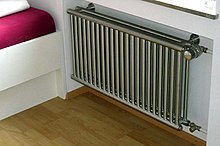Sanitary radiator
Hygienic radiators are part of building heating and are used to warm rooms and buildings, primarily in healthcare and food production. Hygienic radiators are used in hygienically sensitive areas of hospitals, laboratories and food processors. B. also in large kitchens . In the living area they are only used occasionally, specifically by sensitive people who suffer from MCS disease. However, it should be checked beforehand whether the paintwork leads to allergic reactions when heated , or whether the radiator is emission-free during operation .
function
Very high demands are made on hygiene radiators. These radiators should not have convector plates or cladding, hygiene radiators should also enable cleaning and visual inspection on the back of the radiator and wall, so there must be a correspondingly large distance between the radiator pipes or sections. A surface that is as smooth as possible and free of joints and gaps in which dirt and germs could collect is also desirable . Naturally, a high level of resistance to cleaning agents and disinfectants is necessary; according to the Robert Koch Institute (RKI) , radiators should also be able to be disinfected when they are wet. To prevent the risk of injury when cleaning, radiators that are used in hygienic areas should not have any sharp edges. The possibility of wet disinfection or wet cleaning with aggressive cleaning agents places very high demands on painting or coating, which is why even stainless steel radiators are sometimes used here.
Individual evidence
- ↑ RKI Hospital Hygiene (PDF).
